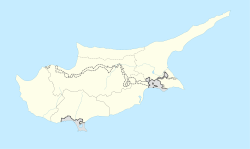Lapathus (Cyprus)
Λάπαθος, 𐤋𐤐𐤔 | |
 A coins of ṢDQMLK, King of Lapathus | |
| Location | Cyprus |
|---|---|
| Coordinates | 35°21′19″N 33°11′52″E / 35.355404°N 33.197851°E |
Lapathus (Phoenician: 𐤋𐤐𐤔, romanized: LPŠ;[1] ‹See Tfd›Greek: Λάπαθος, Lápathos),[2] also recorded as Lapethus (Λάπηθος, Lápēthos),[3][4] Lepethis (Ληπηθίς, Lēpēthís),[5] and Lapithus (Λάπιθος, Lápithos),[6] was an ancient Cypriot, Phoenician and Greek town near present-day Lampousa and Karavas.[7][8]
Name
[edit]Due to lack of evidence, researchers had not been sure weather the Phoenician name of the city was LPṬ (with Teth) or LPT (with Taw);[9][10] recent findings, such as inscriptions and coins with legends, provide the clear reading LPŠ.[10] The Greek and the Phoenician name record, each in its own way, a phoneme of a language prior to them both.[10]
History
[edit]
The foundation of Lapathus was credited to the Phoenician Kitians.[11] Nonnus claimed the name derived from an eponymous Lapathus, a follower of Dionysus.[12] Strabo said that it received a Spartan colony headed by Praxander.[2] He adds that it was situated opposite to the town of Nagidus in Cilicia and possessed a harbour and docks.[2] It was situated in the north of the island, on a river of the same name and in a district called Lapethia (Λαπηθία, Lapēthía).[13]

The coins of the city from the 5th and 4th canturies BC record rulers of the city, in Phoenician: DMWNKS the first, ṢDQMLK, ʾNDR... (shorted name), and DMWNKS the second.[14] The coins of the first two depicted the head of Athena, and the coins of the last two depicted Athena standing and Heracles.[14]
In the war between Ptolemy and Antigonus, Lapathus and its king Praxippus sided with the latter.[15]
The name of the place became synonymous with stupidity.[16]
See also
[edit]References
[edit]Citations
[edit]- ^ Huss (1985), p. 569.
- ^ a b c Strabo. Geographica. Vol. xiv. p.682. Page numbers refer to those of Isaac Casaubon's edition.
- ^ Ptolemy. The Geography. Vol. 5.14.4.
- ^ Pliny. Naturalis Historia. Vol. 5.31.
- ^ Periplus of Pseudo-Scylax, p. 41.
- ^ Hierocles. Synecdemus.
- ^ Richard Talbert, ed. (2000). Barrington Atlas of the Greek and Roman World. Princeton University Press. p. 72, and directory notes accompanying. ISBN 978-0-691-03169-9.
- ^ Lund University. Digital Atlas of the Roman Empire.
- ^ Slouschz, Nahoum (1942). Thesaurus of Phoenician Inscriptions (in Hebrew). Dvir. p. 106.
- ^ a b c Masson, Olivier; Sznycer, Maurice (1972). Recherches sur les Phéniciens à Chypre (in French). Librairie Droz. p. 99.
- ^ Stephanus of Byzantium. Ethnica. Vol. s.v.
- ^ Nonnus, Dionys. 13.447.
- ^ Ptolemy. The Geography. Vol. 5.14.5.
- ^ a b Masson, Olivier; Sznycer, Maurice (1972). Recherches sur les Phéniciens à Chypre (in French). Librairie Droz. pp. 98–100.
- ^ Diodorus Siculus. Bibliotheca historica (Historical Library). Vol. 19.59.
- ^ Suda s.v. Λαπάθιοι.
Bibliography
[edit]- Huss, Werner (1985), Geschichte der Karthager, Munich: C.H. Beck, ISBN 9783406306549. (in German)
 This article incorporates text from a publication now in the public domain: Smith, William, ed. (1854–1857). "Lapathus". Dictionary of Greek and Roman Geography. London: John Murray.
This article incorporates text from a publication now in the public domain: Smith, William, ed. (1854–1857). "Lapathus". Dictionary of Greek and Roman Geography. London: John Murray.

